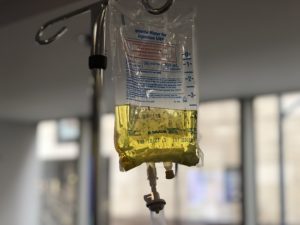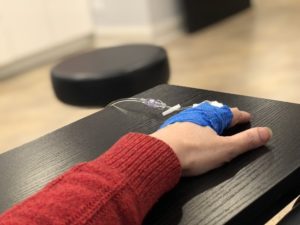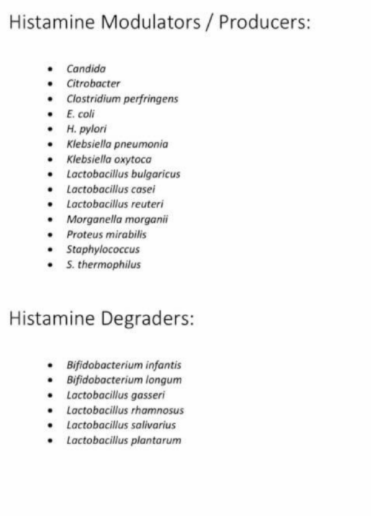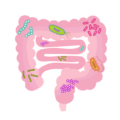In 2017, at the age of 52, I had an unexpected call from my new doctor informing me “I know what’s wrong with you! Come to my office now!” Lifelong increasing chronic fatigue and untreatable Hashimoto’s thyroiditis were my chief complaints.
Past doctors prescribed high dose thyroid medication, which made me feel worse. An autoimmune diet kept me trim but provided no energy. I read adenosine triphosphate (ATP) is required for thyroid production, though ATP isn’t discussed in treatment. Baggage from Effexor and an adverse childhood were also contributors to my health.
Desperate, every relevant supplement and thyroid medication on the market, I tried. Only two were effective. GABA relaxed me, and d-ribose cured my depression 100%. I became bubbly. My personality changed, but after four weeks they both stopped working. Amour thyroid lifted my brain fog for a week. Then, I had side effects. Eventually, I would learn that I, and many members of my family, across several generations, had beriberi or thiamine deficiency. In my case, I had a defect in a key thiamine transporter that made getting sufficient thiamine from diet all but impossible. Unfortunately, I did not learn this crucial information, until I was in my fifties, after years of illness and suffering.
Women’s Issues and Unrelated Problems Begin
While my problems began decades earlier, they seemed to hit a crescendo as I hit menopause. The HRT patch relieved hot flashes, only to fuel a fruit-sized fibroid that split in half with one part covering my rectum. A GP prescribed colon therapy causing severe leg cramps and constipation. A fibroid ablation enabled normal bowel function. Afterward, ozone baths caused my bowel function to stop and I developed air hunger. An ENT said, “you don’t have sleep apnea, there’s another system in your body that is causing air hunger.” He recommends a university clinic over going to different specialists. I pursued genetics.
Starting to connect my cognitive decline, prediabetes, and depression in my grandparents to myself, I went to the MTHFR expert that wrote the report. Her extensive 15-page genetic/supplement report offered no results. After failed treatments from endocrinologists, functional doctors, and big-name clinics like Mercola, I took a chance on Orthomolecular Medicine.
Discovering a Familial History of Beriberi
On the day I was diagnosed with thyroid treatment failure, I found a nutrient interaction article and had a light bulb moment, I’m missing a nutrient for thyroid production. I went to the author, the late Dr. Richard Kunin, San Francisco’s legendary go-to doctor for solving mystery illnesses through nutrients. He was a pioneer in antioxidant therapies, utilizing diet, nutrient and genetic testing since the seventies. His orthomolecular research was the first to verify the use of a mineral therapy in a drug-induced disease.
When his door flung open, I saw wisdom. A rare commodity. Here was this brilliant doctor and a poster of his early collaborator Linus Pauling, staring down at me. Dr. Pauling coined the term orthomolecular meaning “the right molecule in the right amounts.” A doctor like this comes once in a lifetime and I handed him my three-inch binder.
A true scientist, he was able to assess my biochemical individuality, in two sessions.
In the doctor’s intake, the first clue is asking what my parents ate. They ate both Chinese and Western foods, which seemed like no big deal. After lab results, he searches through 300 genes, to find the biggest picture, the gene. Instead of trying to treat multiple gene defects with a supplement. He addresses the root cause first.
He announces, “You’re deficient in thiamine,” and gives me the SNP, called Transporter 2 (SLC19A3) which provides instructions for making a protein called the thiamine transporter, which moves thiamine into cells. Over time, the transporter dissolves.
I had thiamine and asparagine deficiency and riboflavin and glutathione borderline deficiency. The thiamine or vitamin B1 deficiency caused the other deficiencies, but he stays on point and discusses thiamine and only thiamine. He prefaces the session with a history of beriberi and birds fed white rice. Looking back, it’s rudimentary B1 history, but as a patient stuck in the Hashimoto’s/Adrenal Fatigue paradigm for so long, my mind went blank. I remained silent, I didn’t know if I could die from it.
To make matters more confusing. I had stopped taking thiamine after an OATS showed B1 adequacy.
When he told me I can’t convert energy from food, I thought how absurd. He reminded me “the bottom line is how well you absorb the thiamine; not how much I tell you to take”. A Meyer’s Cocktail IV is an initial part of treatment. The next step is collecting data to prove the relevance of thiamine as an essential nutrient required to make energy.
When I Added Thiamine, My Body Began To Recharge
For the first time, I saw a difference in labs and body function. At 300 mg of HCL, my increasing A1C levels fell below the prediabetes range. I almost took metformin at one point, recommended by an integrative doctor. I felt the effects of B1 utilizing B6, through a lucid dream. Treating methylation since 2006, he says “B1 is the gateway to methylation.” With before and after data, he points out B1 upregulating the folate cycling. My energy was increasing. Muscular problems resolved, elevated branched chain aminos were absorbing and TMJ and bruxism disappeared. This was just the beginning. 
I found the thiamine experts, Dr. Derrick Lonsdale and Dr. Chandler Marrs during my titration period. Nuances of thiamine used as a drug to make ATP are available with a detailed overview of beriberi, throughout Hormones Matter. Post to post, the doctors’ addressed every missing piece to my complex puzzle and more. They prompted me to take a closer look inside my dad’s past, one he rarely spoke of, and connections were made.
While titrating up, I had a short bout of diarrhea in the middle of the night. When I decreased the dose, I developed POTS for the first time, the room would spin 24/7 whenever I stood up. My GP referred me to the ER. I was unaware that I was having a paradox reaction. I just upped the thiamine, POTS, and diarrhea resolved.
Chronic TD is called beriberi means “I can’t, I can’t” in Singhalese. The problem is Chinese typically under 80, have never heard of beriberi, and in the US, beriberi is known but assigned as a disease that does not exist anymore or a condition only seen in alcoholics and bariatric patients. Genetic beriberi is passed through families, causing the inability to absorb thiamine from foods.
Beriberi In Two Families Going Back Three Generations
My family history revealed apparent genetics expressing as neuropsychiatric disorders and other conditions that appeared unrelated. Thiamine deficiency (TD) is not easily identified, due to its polysymptomatic nature. Besides the brain, the heart, muscle skeletal, digestive system, and autonomic nervous systems (ANS) need thiamine to function.
My maternal side lived in prosperity and ate a traditional Chinese diet and tropical delicacies. There were 7 members, including my grandfather that had Alzheimer’s (AD) and one family member had Parkinson’s. My grandmother had TD from kidney dialysis. There was TD in AIDS. Untreated hyperthyroidism resulted in cardiac failure mortality at 58. An alcoholic uncle had deficits, anxiety, cancer, and AD. An anorexic cousin refuses whole meals, develops a damaged digestive tract, severe IBS-C, chemical sensitivities, and major depressive disorder.
My paternal side lived in poverty. White rice was a diet staple. There was an aunt that died from child mortality in China from starvation.
After migrating to the US, food scarcity persisted. My grandfather had obesity and type 2 diabetes. My grandmother had sadness after her husband sold their daughter’s papers in China, never to see them again. At 61, my 4’10” grandmother fell over and died from beriberi.
Her wake was the first time my dad went to a restaurant at age 16. He often licked food and preserved it for later. Falsely accused of stealing, the detention center fed him regular meals. Five siblings had short stature and high IQs. His Chinese brother pictured right, was saved by the U.S. Army from malnutrition and assigned to be the radar instructor. There was bullying, anger, and irritation in the three boys. One, a bar owner exhibited extreme behavior like bringing a gun over a trivial conflict that would leave in-laws aghast.
Ocular diseases, restless leg syndrome, circadian rhythm disorder, cancer, some OCD and hypermobility, and osteoporosis appear. There was TD from chemotherapy. Two aunts left behind in China lived to be centurions and a daughter has fibromyalgia, depression, and other deficits.
Connect the lineage with a pregnancy gone wrong.
Genetics and a Traumatic Pregnancy Sets the Stage for Life
Pregnancy, a hypermetabolic state, requires sufficient thiamine for the development of a healthy child. My mom, a robust woman, was overmedicated and bedridden for a month post-pregnancy. She recovered but my brother was permanently disabled. My brother was born with uncontrollable hyperactivity and oppositional disorder. Our theory was his oxygen supply was cut off to his brain, but it was thiamine deficiency.
Two years later I was born. As a young child, I was hypoactive and didn’t move much. In grade school hearing loss was detected. Early memories included some clumsiness and not having the strength to swing on monkey bars like other children. My first feelings of frustration were over homework, especially math. My overall health waxed and waned and would not draw attention until high school when tiredness, poor memory and learning disabilities appeared. I was bullied by my older brother.
Nine years later my younger brother was born, bruxism as a baby, was his first sign of thiamine deficiency.
The next generation, symptoms of thiamine deficiency show in a gifted child.
Neurological deficits ranging from severe to minor were a sign of impaired methylation since birth.
My mom’s prenatal diet was traditional and American, and we were bottle-fed. This was in the ’60s when women were weaned off breastfeeding.
Now connect the genetics, the pregnancy and untreated thiamine deficiency in a parent and sibling.
A Genius Mind Uses More Energy and Requires More Thiamine
My dad invented the on-line TV guide in the eighties. In a constant state of fight-or-flight, working through the middle of the night on patents, sugary snacks were comfort foods to compensate for early years of food deprivation. The “night owl” term we used was circadian rhythm dysfunction. Thiamine is an overlooked nutrient required for sleep and the breakdown of cortisol.
When my brother’s hyperactivity was unmanageable, breaking things, beating the ADD out of my brother was habitual. A dysfunctional limbic system causes knee-jerk reactions to uncontrollable rage. I just learned that my seemingly nice uncle, an alcoholic, frequently tried to beat the homosexuality out of his young child.
A psychologist thought violence only happens in alcoholics. I think this limited view needs to be updated to include excess processed food intake. I remember “children should be seen and not heard” commercials as a child when hitting and spanking was more accepted.
In 1983, Dr. Kunin cited Dr. Lonsdale’s research that describes the B vitamin link with violence in Mega Nutrition for Women, “patients whose violent behavior was inexplicable by conventional medical diagnosis were found to be deficient in one or more B vitamins, notably B1, B3, and B6”.
During the Covid-19 shutdown, I thought of TD when incidences of abuse spiked, homelessness and random violence spread, and middle-class families now become dependent on food banks.
Poor Health After Antibiotics
As a young teen, I lost my glow, I looked tired, and my skin had a jaundiced yellow-greenish tint. In high school, after a round of tetracycline for transient acne, I was never the same. My metabolism stopped and I gained 40 lbs. I also have leptin deficiency and so I am always hungry. Napping after school was an everyday event. My limited thyroid test given showed normal thyroid-stimulating hormone (TSH). I was also constipated but didn’t know it until middle-aged after I was diagnosed with Hashimoto’s. In my 20’s I took antibiotics for chronic strep throat. Uninterested in nutrient dense foods, I subscribed to carb loading and high-intensity aerobic activity, the trend of the day.
Changes in My 30’s and the Promise of Modern Medicine
When my dad had side effects from sleep medication, he did his research, bought supplements for every system in the body, and stopped going to doctors. He got the family off of rice and put us on B vitamins. Uneducated in vitamins, I gave up on them too soon. I wasn’t taking enough! My mom’s acupuncturist treated my ADD, but I strayed when a well-meaning friend steered me towards pharmacology, and I took Effexor. The damage showed up over the next decade when increased nervous system and mitochondrial dysfunction begin.
Loud bar music in the back of my unit initiated chronic insomnia in my forties. I had open mouth breathing. Elevated cortisol and night sweats woke me at least 8 times a night. If I was mad, I’d have an instant hot flash and sizzle like a red bull. I lost my sex drive. After quitting Effexor, elevated thyroid TBO antibodies appeared. Later diagnosed with sensorineural hearing loss, the psychiatrist prescribed sound therapy but the condition isn’t curable.
Musculature problems began, I had an unrelenting frozen shoulder from a gym accident, and at one point, I had ataxia and couldn’t walk straight. After a trip, while in Hurricane Ivan, I was unable to walk for a month with ataxia. I once met an advanced multiple sclerosis patient, that experienced the exact same symptom from Ivan. The cause was thiamine deficiency in the cerebellum, the part of the brain that controls movement and walking.
For work, I illustrated 300 skylines from around the world and market them on Etsy. My fine motor skills and artistry remain superior, but my spatial organization was nonexistent. I was very messy. Taking GABA hampered work stress, but I couldn’t cycle it from thiamine deficiency. Managing inventory and college students wore me out. One told me “You can’t retain what I tell you”. Finding my car in large parking lots was often challenging. The hippocampus circuitry requires thiamine for short-term memory function.
Orthomolecular psychiatry has proven to treat and manage these types of disorders with nutrients and diet, as the first line of defense. There was no need for antidepressants.
After My Diagnosis, I Learned My Parents Were Already Taking Thiamine
When I told my dad about my thiamine deficiency, he pulled out a bottle of thiamine labeled anti-beriberi. He was taking B1 for cardiac support. The heart and brain consume a vast amount of energy and require thiamine to meet the demand. My mom took benfotiamine successfully for shingles, a neuropathic pain.
When I told my original acupuncturist, about my diagnosis he said, “I already know you have beriberi, just take B vitamins and lots of them. You don’t need my herbs.” He had been treating me for dysautonomia, twenty years before I developed POTS. I detested the point because his needling pressure hurt. No questions asked; he needles points by observation and pulse, Western characterization in diseases have no significance.
Part of the treatment for dysautonomia is a needle to the center of the philtrum, this point prevents fainting. Another needle is inserted into the center of the forehead and one on top of the head for balance. Traditional Chinese Medicine (TCM) healers identify liver and lung channels weakness two decades before western medicine.
The New Doctor Damaged My Health In Only Eight Months
Twenty nineteen was a bad year. Dr. Kunin sees Vitamin C deficiency and signs of anemia and then retired. I stopped getting IVs. I would still nap after taking them. My trusted acupuncturist, also a nutritionist moved. I began dry coughing a lot, which later I learned was a sign of TD. Then I met the worst doctor ever.
I showed her, Thiamine Deficiency, Dysautonomia, and High Calorie Malnutrition and she handed it back to me and said “Oh, another patient brought this in the office.” I interviewed another doctor and told him I have TD and he replied with, “what’s your point!” and referred me to a doctor out of state.
I settled on the first doctor, and everything started wrong. She put me on a high-dose thyroid medication without titrating, and Low Dose Naltrexone (LDN), which gave me a stomachache. She wanted me back on LDN after I told her I had side effects. She recommends NAD instead of Meyer’s Cocktails which includes thiamine.
By the time I realized I was in a hyperthyroid state, the damage had begun. A cascade of beriberi symptoms begins. When one symptom would go away, another would begin. The neuropathy was more long-term. I had resting tachycardia, lactic acidosis after five days of yoga stretch that caused feet neuropathy and then trigger finger. All the doctor could say was “I had candida overgrowth”. The cause of candida was that I had a weakened immune system from TD. I watched videos on lactic acidosis to explain it to her.
When I saw an eleven year old’s homework on glycolysis it made me wonder how much doctors remember from medical school.” I tested the doctor and asked her “What does pyruvate convert to?” She answered incorrectly.
I was developing non-alcoholic Wernicke’s encephalopathy (WE), acute short-term memory loss. I almost walked out of a restaurant thinking I paid the bill. I couldn’t remember putting a credit card back in my wallet and arguing with the clerk after she had handed it back to me. Once I read, “if you think you’re deficient in thiamine, get an IV right away.” After a series of Myers Cocktails with phosphatidylcholine, the progression stopped.
Another doctor got me off the thyroid meds, yet wet and dry beriberi symptoms continued. My left-hand lost circulation and turned hard and purple. The back of my neck hardened and my backside turned into butter. I had unintentional weight loss and my hand reflexes slowed. My minerals were becoming unbalanced. I contacted a refeeding syndrome clinic, for a consult, but was turned away because I wasn’t anorexic. A few months later I traveled to Hawaii and made a mistake.
Orthomolecular Medicine Rescues Me Again
Accidentally packing thiamine HCL instead of TTFD, the HCL initiated my paradox reaction and I had diarrhea several times the first night. Every day I napped from the sun’s UV rays. Excruciating muscle cramps sent me to Dr. Pritam Tapryal, Honolulu’s IV doctor specializing in chronic fatigue syndrome. Thiamine handouts, a stockpile of capsules and vials of B1 were waiting for me.
He calculates that I needed 600 mg of IV thiamine based on the length of time I had been feeling unwell. With an iron load before the second IV, I felt a surge of energy – I got ATP! My vagus nerve stimulated peristalsis and excess fermentation stuck in my body for three months finally released. Elevated liver enzyme activity and low blood pressure normalized. Afterward, I found a doctor willing to provide high dose thiamine therapy at home.
I went back to the doctor that said “what’s your point” when I told him I had thiamine deficiency and requested 600 mg of parenteral B1 instead of 100 mg. A bit taken back, he shows compassion and custom orders 500 mg of B1 in a Myers Cocktail, after I explained my recent experience. The IV manager thought I was an ICU patient, but I wasn’t. It was the dose I felt best on.
High Dose IV Thiamine Therapy: From A Patient’s Perspective
A series of high-dose thiamine (HDT) IV treatments, turned into an epigenetic treatment going on two years and two months. I’ve taken 100,000 mg of parental thiamine to this date. Infusions continued to sustain therapeutic effects and increased thyroid production. Unknown cause of malabsorption required ongoing infusions. Resolved through extensive pre-and post-labs.
I self-directed my treatment and gauged myself. I found thiamine articles from all over the world, but high-dose thiamine information was limited to WE treatment only. I received no medical advice on thiamine therapy from allopathic doctors that had clinical nutrition education, or from a young orthomolecular doctor or GP. 
I had two to three IVs per week the first year that included 500 mg of thiamine. The longest time without an IV was three weeks at the beginning of 2020 and eleven days at the end of 2021. Below is a 12-month summary, from a 55-year-old woman with unrecognized lifelong thiamine deficiency from a SLC19A3 gene defect.
Journal From Long Term, IV, High Dose Thiamine Therapy
My high-dose thiamine regimen began 11/21/2019. This is the Meyers Cocktail titration period:
- 2 infusions of 200 mg of thiamine in 2 weeks in end of Nov. to Dec.
- 5 infusions 300 mg of thiamine in 2.5 weeks Dec. to Mid Dec
- 2 infusions 400 mg of thiamine in 2 weeks Mid Dec. to January.
- 500 mg of thiamine 2 to 3 times a week were taken in the middle of January.
11/2019 Concerned about anaphylaxis. Only a few teeny bumps around lips developed and disappeared after the first day. Visual clarity is the first sign of improvement.
12/2020 – Foot neuropathy and trigger finger for 4 months, resolved with 7 IV’s spread out over 4.5 weeks. The IV thiamine doses were 300 mg or 200 mg. Dexa scan shows osteopenia in lower back and femur and only 3 lbs. of lean muscle mass, muscle wasting, a hallmark symptom of beriberi.
OATS test taken a day after HDT infusion – tested B1 borderline deficient. Borderline and deficient in minerals and vitamins except manganese, doctor thought something was wrong with lab.
1/2020 – Right mucosal lining was demyelinating and slightly bleeding for a month, saw glitter. Zonulin levels over 800, the doctor told me not to be concerned, but I was. Slight rectal bleeding.
An unintentional fast in cold weather caused syncope. Broke out in an intense sweat, became faint and lost appetite. Leaned against buildings every few feet to get home, no thiamine in am. Sitting on bench resolved symptoms. MCV increases to 100, normal range is up to 95.
Tested negative for panel of inborn errors of metabolism. Autoimmune panel negative except – Arthritis – equivocal, Thyroiditis- out of range, Epstein Barr – negative.
2/2020 – New formulation of phosphatidylcholine, with small amount of dextrose without B1 was a mistake.
On three-week break, nighttime driving vision had decreased. Resumed Meyer’s Cocktail after break, fatigued, fell asleep in IV chair after IV. Reduced thyroid medication from I grain a week, increased after break to 3.5 grains a week. A1C 4.8 increased to 5.2 after break.
Right quadrant of my upper teeth dropped down. Oral surgeon said “not pathogenic of disease”.
Last visit with Dr. Kunin. Concerned I looked just as depressed as when we first met. I was happy to see him, unable to express it. Continue a more DIY approach and TCM, “the Chinese have found ways to treat that western medicine has not figured out, and one day technology will be so advanced doctors won’t be necessary”. He handed me the keys and said, “Figure it out on your own.”
3/2020 – Introduced high fat diet. Lost 3 lbs.in a week. Severe leg cramps from foot to shin. During an IV, felt leg cramping. Normal cholesterol increased from 260 to 400. Stopped diet. No B1 in fat.
4/2020 – Lowered stress from semi-retirement and resting. IBS starts to resolve for the first time at 55. Felt extreme chill one day. Took injectables at another doctor’s office due to shut down. I took 100 mg B1 in a B complex in intramuscular (IM) with B12 to ease B1 ‘pinch’, plus IM biotin for a month. Not as effective as HDT infusions. Combination of B1 with complex and biotin had best results.
5/2020 – Meyer’s Cocktail and 350 mg of NAD back-to-back infusions lifted brain fog profoundly. Able to do tasks I couldn’t perform prior. I cried with joy, my cells were not permanently damaged from past use of Effexor and antibiotics. Unable to replicate treatment. Oral Inositol reduced elevated triglycerides dramatically, then stopped working. IBS came back off and on.
6/2020 – Tested borderline low on calcium, choline, magnesium, B5, B12, Vit C, K2, zinc on a three month average. GI lab shows mal-digestion, metabolic imbalance, and dysbiosis. Stomach pain from psyllium and flax, phytobezoar build up, rash on neck since 2019 getting worse, insomnia resolved.
7/2020 – Severe anemia showing and severe muscle weakness. I couldn’t lift a 5 lb. weight. Acute memory loss, almost walked out of lab before taking the lab. Waking up early in am in summer at 8:00. Hemoglobin normal and then drops frequently, IV doctor sees bleeding. Ophthalmologist finds arcus build up from high cholesterol, strong arteries, and recommends latanoprost for glaucoma after field test.
8/2020 – Decreased parenteral 500 mg B1 to 300 mg to test if high dose thiamine is depleting B12. Began coughing after 7 days. Post NAD IV lab tested B12 deficiency, causing hemoglobin and T3 deficiency. Acupuncture treatment creates switch sensations throughout body allowing oxygen flow, heart channel under arm point pulsated – oxygen and lung channels communicate. Leg bruising – Vitamin C deficiency. Insomnia came back when B1 parental dose decreased, never resolved fully after increasing B1.
9/2020 – ANS dysfunction – uncontrollable body flipping in bed two nights in a row, movements like a fish out of water. Resumed 500 mg of prenatal B1 after two weeks at 300 mg. Ophthalmologist said “you look more alert”, compared to two months ago. Started IM Mic-B and hydroxocobalamin, 5 days a week. IBS-C decreased with B12 IM. Coughing on Lipothiamine, switched permanently to Allithiamine, cough resolved. Normal zonulin levels return, reduced gut inflammation. GI didn’t order endoscopy after I told him something hit my stomach when walking and had rectal bleeding. He wrote IBS on notes. Stopped EDTA IVs for cadmium after a few treatments, when urine began foaming.
10/2020 – Latent deficiencies appear: B12, CoQ10 malabsorption. B1 not absorbing. Vitamin C deficiency appears, lifelong subclinical scurvy, bleeding gums, gingivitis, pilaris keratosis, bruising, poor iron absorption, rectal bleeding, low tyrosine. Sick people are low in B vitamins and Vitamin C. Repeated thiamine depletions cause heavy Vitamin C deficiency in lung, kidney, thymus, and liver.
Tested positive for Intrinsic Factor AB, Pernicious Anemia (PA). Hematologist defensive when I asked him if TD can cause anemia, cancelled next appt., told me to see a GI. Doctors booked from Covid-19 delays.
Oral surgeon cleared teeth shifting. Orthodontist ordered aligners, short teeth roots in scan.
Trialed compounded thiamine cream from Lee Silsby pharmacy and replaced TTFD.
11/2020 – Stomach pain increasing after meal. Twelve days in, I thought I was going blind. The thiamine cream wasn’t absorbing. Indoor and night vision blurry. Back to TTFD and Myers Cocktail together. My vision came back, but not as clear before getting blurry. Mild paradox reaction, a bowel movement in the middle of the night.
12/2020 – Endoscopy shows chronic gastritis, h. pylori and peptic ulcers. A combination of a lack of nutrients cause ulcers, including B1. Refused triple therapy (antibiotics and PPI). Treated with cabbage, herbals, mastic gum. ION Panel indicated GSH and potassium deficiency, lactic acidosis (TD), ketosis, oxidative stress, transmitter deficiencies and metabolic syndrome.
Elliot Overton of EO Nutrition interprets mitochondria in battleship mode, suspects mold toxicity. Unseen mold or water damage. Incontinence and frequent urination. Second ophthalmologist told me don’t take latanoprost. MCV high still high with regular IM B12, since 10/20. With small veins and bursting arteries, it’s difficult to maintain IV’s.
In 2020, my health was like my dad’s. My hearing and vision deteriorated, I was unable to hear people speak with masks on and had difficulties focusing on conversation in noisy rooms. Gingivitis developed into periodontal disease; teeth aligners require lifetime use. My dad is deaf in one ear, and now going blind in the second eye and had the periodontal disease the same year and wears dentures.
Observations at 43,500 mg IV Thiamine After 13 Months
Intravenous therapy can target issues in ways oral thiamine cannot reach.
Improved thyroid production, A1C, insomnia, IBS and CFS, overall energy level partially improved. Foot neuropathy and trigger finger resolved. Cocktails with phosphatidylcholine, iron, and NAD, had increased effects, latent deficiencies appear, no nutrient depletions from high-dose thiamine.
Infection, gastritis, ulcers during treatment caused malabsorption. Reducing thiamine caused insomnia to reoccur and acute vision reduction, increased ANS dysfunction caused temporary uncontrollable body movements. Increased dose of 300 mg to 500 mg of B1 resolved uncontrollable body movements and regained vision.
I saw one patient vomit, and a patient have nausea during 300 mg B1 Meyers Cocktail.
ROS from unknown cause extends treatment into 2021.
High Dose Thiamine IV Therapy, Toxins, Diet, Labs, and Gigong
In 2021, I tapered to two IVs a week and increased the 500 mg to 600 mg mid-year. Hot flashes returned after 5 years of remission causing a three-month setback. Insomnia made me delirious and had to take naps. PEMF bio-mat calms the nervous system to assist in sleep, without it I’ll wake up a few times during the night. For over 10 years, I wake up and urinate once a night. My eyes became blurry and I walked slowly like an old lady for a short period. Daily clear phlegm wants to come out since 2020 when I eat.
In spring my bloodwork showed Stachybotrys and Aspergillus mold. I found growth on papers in a storage box against a wall with the laundry room on another side. Condensation went through the wall.
With my gut healing and IV therapy, my TBO antibodies levels reduced significantly. The increased T3 raised my steroid hormones. Reducing thyroid medication again was a real possibility. IBS-C was resolved by mega-dosing powder magnesium with fiber, B1 and B12. I once had an offer to see the world authority on IBS-C, though all I needed was a good form of high-dose magnesium. I was feeling better until I experienced unexpected setbacks.
Everything Changed With Two Major Endocrine Disruptors
Microscopic brick debris during construction flew under my windows. Debris flew inside over 50 ft. and landed everywhere, never thought my eyes and lungs could clear it. Due to an HLA-DQB1 gene defect, I’m unable to break down mycotoxins (mold). Mold is an anti-thiamine factor and it oxidizes B1 and B12.
When inflammation started to calm down, my hallway went under remodeling, and material debris and paint fumes went under my door. The chemicals shut down my thyroid. Antibodies rose from 180 to 535. Inflammatory markers that were improving became elevated and deficient. My killer cell function, HNK1 (CD57) level was 50 and now 18. The doctor thinks I have Lyme. I’m testing for MARCoNS, a staph infection that resides deep in the nasal passage, due to sinus inflammation from the biotoxins.
After trialing Cholestyramine for mold binding, it made me constipated. My acupuncturist gave me a two-hour treatment to undo the damage. To detox, I use an FIR infrared sauna on the mat. I’m getting an ERMI test kit to test other rooms, an air test hardly detected mold.
HDT Isn’t a Standalone Treatment
With the amount of IVs I took, I tested questionable foods. A few small gluten-free snacks put me into a comatose within 20 minutes. Less than two ounces of coffee initiated leg/foot cramping. I never had this problem a few years ago. Removal of processed carbs is the only way I can maintain my thiamine storage.
Staying in mild ketosis, on a paleo diet is optimal for me. When I tried high-fat and vegan diets, they caused deficiencies. I have a nonfunctional gene cluster FADS1/FADS2, that requires the consumption of EPA and DHA found in seafood. Drinking concoctions of vegetables and minerals activate B vitamins throughout the day. TD causes nitric oxide deficiency and I replete myself with nitric oxide greens. My one kryptonite food is liver, it elevates my copper. Using food as medicine supports my overall immune function as I recover from Chronic Inflammatory Response Syndrome.
My hydrochloric acid is deficient from TD, and I have low gastrin. I’ve taken 13,000 mg of Pepsin Betaine and feel no sensation. Apple cider vinegar doesn’t seem to work. My amino supplements aren’t absorbing. I also have oxalates, Elliot recommends more B6 and I’ve increased molybdenum to meet my sulfur intake.
I take a blend of B1 that includes: 900 mg Allithiamine, 300 mg benfotiamine and 500 mg thiamine HCL. Over 900 mg Allithiamine and sulfur come up. Before a Meyers Cocktail, I’ll soak in magnesium salts. I’ve increased all the B’s and take them with other essential nutrients throughout the day in moderate to high doses. I require biotin intramuscularly every few weeks, otherwise my nails chip, this started last year. My transporter may be dissolving.
Utilizing Biomarkers and Managing Nutrients
Every six weeks I rotate biochem panels and adjust diet and supplements. My weaknesses this year have been lipids, omegas, aminos, and inflammatory markers. My B12 continues to pool due to suboptimal thiamine levels unable to utilize B12, so I stopped testing. I inject 35 mg of hydroxocobalamin a week, plus sublingual, and hemoglobin is always on the lowest end of normal after I had pernicious anemia. Mold is the suspect cause. I may also have scar tissue from ulcers and scurvy of the colon. The GI doctor recommends an endoscopy once every three years when there’s been a problem.
I’ve found nutrient panels reliable when B1 is extremely deficient. On two occasions my lactate tested normal. Then I had beriberi symptoms after I took the labs on the same day. This was from eating beans and walking in sun, which forced me to sleep. My citric acid markers were normal on an ION panel and I was in ketosis, but the clinician didn’t know I had POTS on the morning of the lab. This was from a three-day fast suggested by a doctor. Thiamine deficiency can worsen on a dime.
Diagnosed with TD on a SpectraCell micronutrient panel, I had long-term B1 deficiency. Normal B1 levels are misleading on my labs once there’s been intake. The Vibrant America panel showed B1 malabsorption at 35,000 mg of parenteral B1. I’ll continue with this panel and monitor nutrients connected to B1.
My doctor’s friend offered me the two-part transketolase lab for research, but my doctor forgot to arrange the sampling. I was upset at the time, but it doesn’t matter now. I manage myself by how I feel. With Excel journaling, the more elements I add, the more clarity I receive. Observing physical changes are equally valuable to the labs.
A Revisit to Energy Medicine That Compliments Nutritional Balancing
I recently discovered group Primordial Qigong. I haven’t found any other modality that has the same restorative benefits that give energy instead of using energy. Movements connect the body, mind, and soul with the focus on living in the present. Gentle stimulation of systems and body parts creates rejuvenation from within. Who doesn’t want that?
Dysautonomia, the fainting prevention point, is taught in practice. The bank of hands faced together inverted pushed downwards from the forehead over the philtrum encourages balance. Made for masses with no resources, it only requires continuity. This is a welcoming alternative compared to the nutrient-depleting therapies, recommended by for-profit western doctors that made my health worse when they didn’t know what they were dealing with.
At 100,000 mg Of IV Thiamine – It Feels Like I’m on a Train I Can’t Get Off
Overall, the quality of my life has improved. I no longer need to lie down and sleep during the day, even if I feel tired. I’m more active in mind and body. I can sit up and read, wake up earlier, and exercise. My processing speed and speech are faster. The left side of my brain is strengthened. I did audits on my condo association to trace missing dues and one over BlueCross when many claims were unpaid. My brain fog had been too severe to do this previously.
Neuropsychiatric issues appear in less frequency. I still experience forgetfulness and minor learning impairments. Irritation is manageable. I believe some brain function is permanently damaged along with hearing loss. Considering my long-standing history, I’m pleased with the results even though it is only a partial recovery.
Since my body called out for a high dose, there’s a chance I can regress. At 11 days off the IVs, I was deficient in Co2. I don’t know if the thiamine coenzymes can function without high-dose therapy because of my genetic liability. I’m patiently waiting to see how my body changes after the toxins are eliminated and figure out how to taper down from the IVs.
Final Thoughts
Thanks to Dr. Marrs and writers on HM for elucidating thiamine awareness, I learned how to use thiamine as a drug at a time when I needed it most.
Through luck, I found nutritional clinicians that made a significant difference in my health. Educated in Dr. Lonsdale’s thiamine research, they applied his nutrient-based knowledge into their practices. Understanding that beriberi still exists today and is not an ancient scourge from yesterday, is critical.
By assimilating the genetic impact of beriberi and orthomolecular dosing, I’m regaining health in my late fifties. However, no patient should have to spend a lifetime finding a treatment based on luck. There’s no reason to it’s all here: Thiamine Deficiency, Dysautonomia and High Calorie Malnutrition, Derrick Lonsdale and Chandler Marrs; www.orthomolecularmedicine.org
We Need Your Help
More people than ever are reading Hormones Matter, a testament to the need for independent voices in health and medicine. We are not funded and accept limited advertising. Unlike many health sites, we don’t force you to purchase a subscription. We believe health information should be open to all. If you read Hormones Matter, like it, please help support it. Contribute now.
Yes, I would like to support Hormones Matter.
This article was published originally on February 14, 2022.























